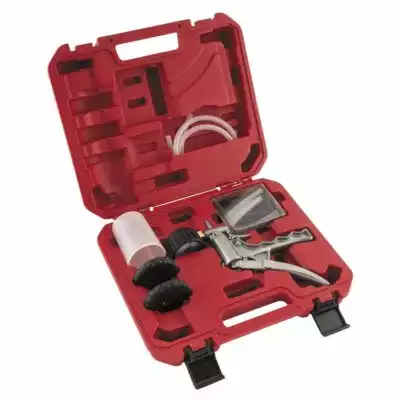Your motorcycle brakes are critical components of your bike. If your engine fails, you can cruise to the side of the road and stop. A puncture can be frightening, but you can slow down. If your brakes fail, it could be catastrophic.
For this reason, you must keep your brakes in top condition, and one of the most straightforward home mechanic jobs is bleeding the hydraulic brake fluid. This article describes how your brakes work and how to bleed them.
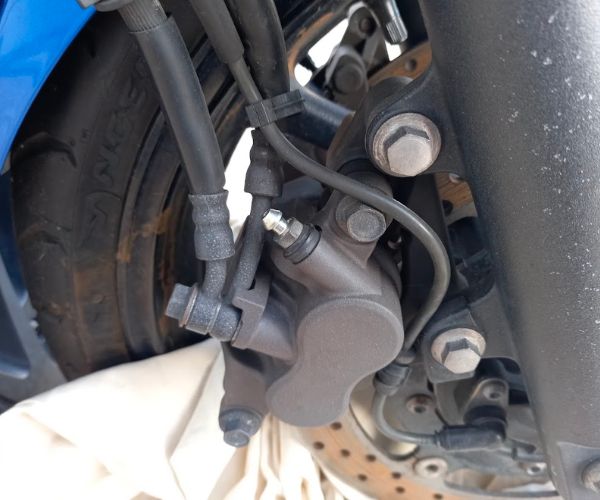
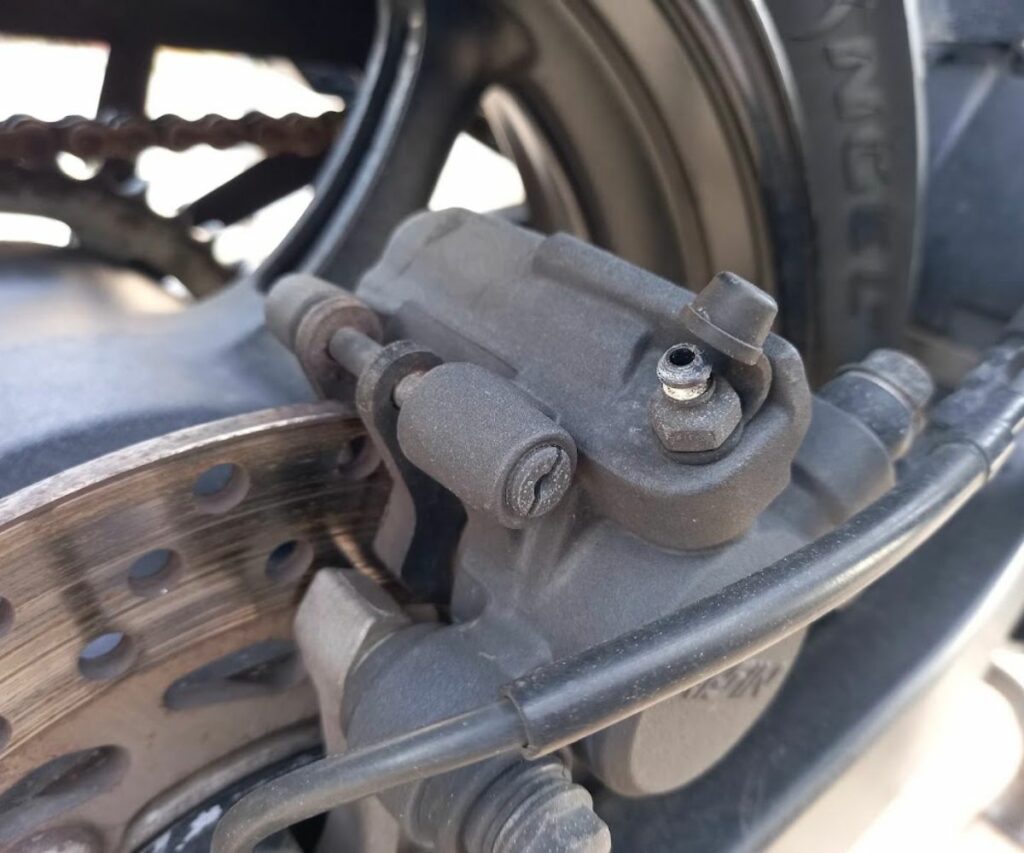
Preparation
Bleeding your brakes doesn’t require a lot of preparation, but the following elements are essential.
- Gather your tools:
- Cross head screwdriver
- Ring spanners: 8, 9, or 10 mm
- Bleed kit: You can buy a ready-made kit or just buy a piece of rubber tubing and use an old plastic bottle to drain the used fluid into.
- Plenty of fresh brake fluid
- Cloth
- Find a level area for your bike.
- Put your bike on its center stand or paddock stands.
- Cover any exposed paintwork with cloth and have paper towels and spare cloths at the ready.
Step-by-Step Guide to Changing Motorcycle Brake Fluid
These basic steps for changing or bleeding your motorcycle brakes apply to both front and rear brakes.
#1. Place plenty of cloth around the brake caliper and brake fluid reservoir to catch any spillages.
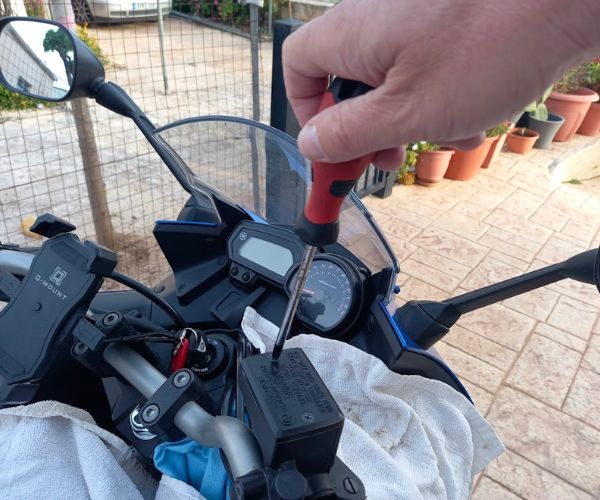

#2. Remove the brake fluid reservoir cover.


#3. Top up the brake fluid level if required.

#4. Remove the bleed screw dust cover.


#5. Put the spanner over the bleed screw, allowing enough space to turn it between ¼ and ½ a turn.

#6. Connect the bleed pipe to the bleed screw.
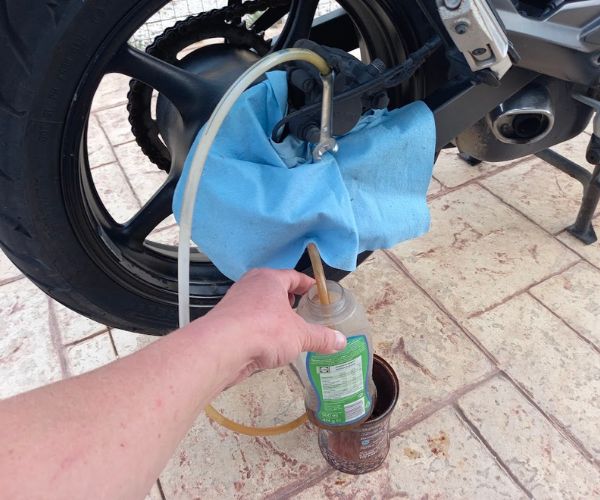
#7. Put around an inch of old brake fluid in the drain bottle.
#8. Put the free end of the bleed pipe into the drain bottle so that it’s submerged in the brake fluid.
#9. Pump the brake lever several times and then hold the pressure on.

#10. Next, open the caliper bleed screw until you feel the pressure release at the lever.
#11. Then, close the bleed screw as soon as the lever bottoms out.
#12. Finally, top up the reservoir if required.
#13. Repeat the bleeding process steps until the fluid runs clear without air bubbles. Clean up any brake fluid spills. Remember to refit the bleed screw dust cover.
Components of a Motorcycle Hydraulic Brake System
So you can be prepared to troubleshoot, it’s worth covering the system’s essential components and how they work.
Basic Motorcycle Braking System
Only a few elements make up a basic hydraulic braking system on your motorcycle.
- Brake lever: The lever may have a span adjustment wheel. A vast array of aftermarket levers in different colors and designs are available to customize the look of your motorcycle.
- Brake-fluid reservoir: The standard reservoir may be connected to the master cylinder or a separate reservoir. Aftermarket reservoirs are available.
- Master cylinder and piston: The brake lever moves the cylinder, pressurizing the system. High-flow master cylinders can be fitted if required, but it’s not usually necessary.
- Hydraulic brake lines: Until recently, most motorcycles were supplied with standard hydraulic hoses. More sport-oriented motorcycles may have come with braided hoses as standard. Braided hoses are now more common.
- Any of a number of brake caliper varieties:
- Single-piston sliding caliper: On small, light motorcycles, a single sliding piston type is standard. In this setup, a single-caliper piston is operated by the brake fluid pressure. To maintain pressure on the other side of the rotor, the caliper is free to slide. This is also a common type of caliper used on rear motorcycle brakes.
- Multi-piston brake caliper: An improvement on the single-piston caliper is the twin-piston caliper. Brake performance is enhanced, and the pressure is evenly applied to both sides of the rotor.
- Brake pads: Brake pads provide friction to slow the rotor when you operate the brake lever.
- Rotors: Rotors are metal or carbon discs attached to your motorcycle wheels.
ABS Braking System
An ABS braking system has the same components as a standard brake system, plus some additional parts:
- Toothed disc on each brake rotor: The speed sensor monitors the spaces on the ABS ring to detect when the wheel stops rotating.
- Wheel speed sensors: The sensor feeds this information to the ECU if your wheel stops rotating.
- Electronic control unit: The ECU uses inputs from various sensors to determine if the wheels have locked up and then take appropriate action.
- Pump and actuator unit: When an ABS kicks in, you will feel a pulsing on the lever. This is the pump unit removing and reapplying the brake pressure rapidly. The pulse allows the tire to regain traction on the road and apply braking without locking the wheel.
- ABS warning light: Indicates a problem with the ABS.
How Do Hydraulic Motorcycle Brakes Work?
The operation of a hydraulic brake system is quite simple. Your brake lever operates a piston in the master cylinder, which pressurizes the hydraulic brake fluid in the hose. The fluid passes the pressure to the caliper, where a piston forces the brake pads into contact with the brake rotor.
Of course, although the basic idea is simple, making your brakes effective while retaining the braking feel involves complex engineering, which is the topic of another article.
Front Brake
Motorcycle front brakes typically have a reservoir and master cylinder mounted as one piece on the right handlebar. The reservoir sits above the master cylinder and brake lever. Hydraulic hoses connect the master cylinder to the calipers.
Front brake systems with a single disc will have one hydraulic hose. Twin-disc systems can have either a single hydraulic or double-hose setup.
Motorcycle front brake calipers come in a range of fitments, from single-cylinder sliding calipers to exotic six-cylinder varieties.
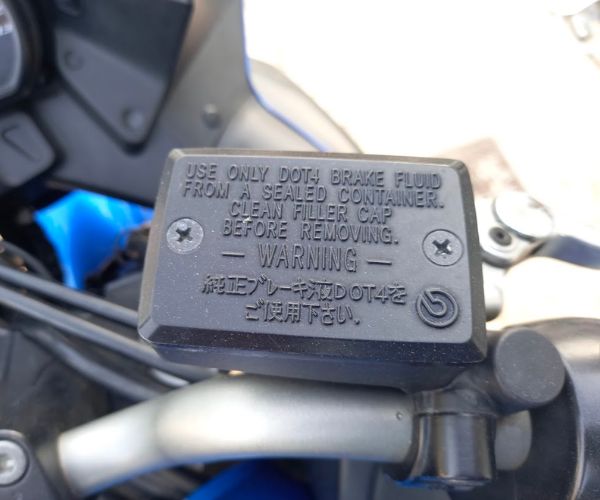
Rear Brake
Most motorcycle rear brakes have a separate fluid reservoir and master cylinder. This is simply due to the lack of space around the back brake foot pedal. A short hose will connect the reservoir and cylinder.
I’ve never seen more than one brake disc on a rear wheel, but I’m happy to see photos of this type of setup if anyone has. There are two reasons for this: First, a single disc is more than enough to lock the back wheel, and two, it would be overly complicated.
Rear motorcycle brakes are simple and often use a single sliding piston caliper.
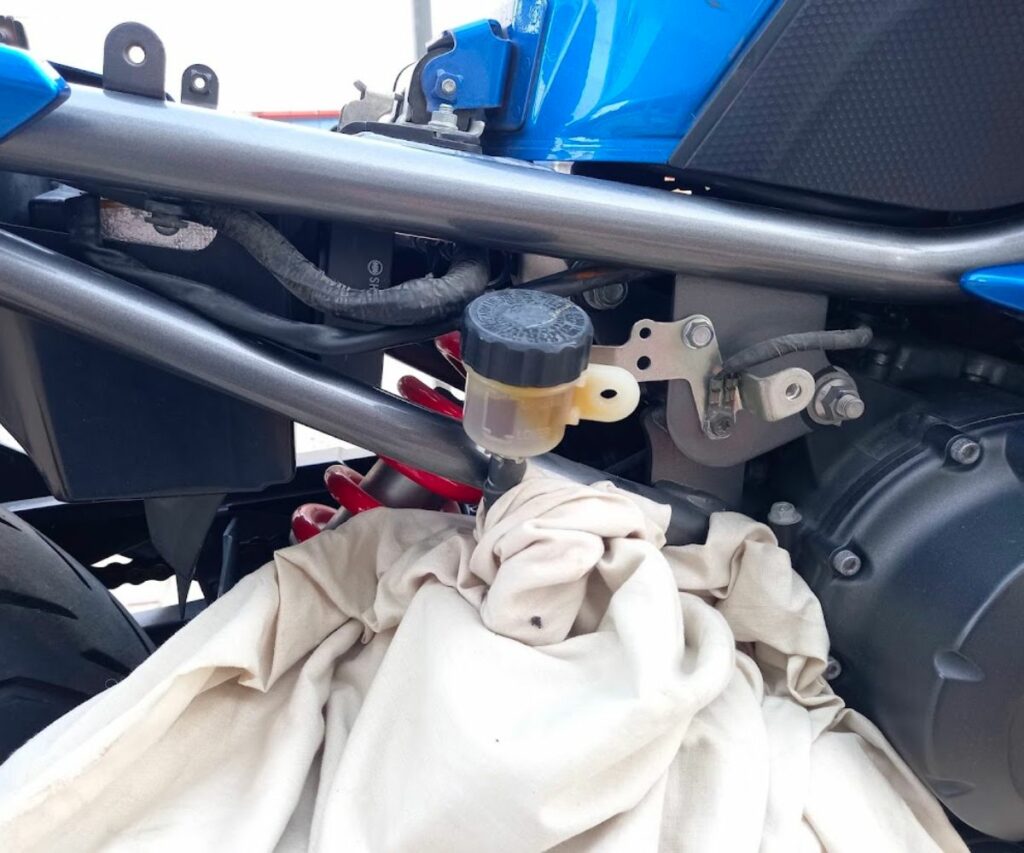

Motorcycles with ABS
Adding ABS to your motorcycle’s braking system can complicate the brake bleeding process. Following the manufacturer’s recommendations is essential when you bleed motorcycle brakes with ABS.
In most cases, the manufacturer will specify in what order the brakes should be bled to ensure their correct operation. Others may need extra steps.
Problems Bleeding Motorcycle Brakes
In most cases, bleeding your motorcycle brakes is a reasonably straightforward process. However, as with anything mechanical, we often get thrown a curveball!
Bleed screw seized
Your motorcycle brake calipers are in a very exposed position. If you ride through the winter, particularly in an area where salt is used to de-ice the roads, the bleed screw can seize.
If the bleed screw seizes, don’t force it. You could end up snapping the screw off, making the situation worse. The first cure is to soak the screw in a release agent, such as WD40 or similar.
You can also try using brake fluid. If this doesn’t work, then you may be able to send the caliper away for repair or swap it for a reconditioned item.
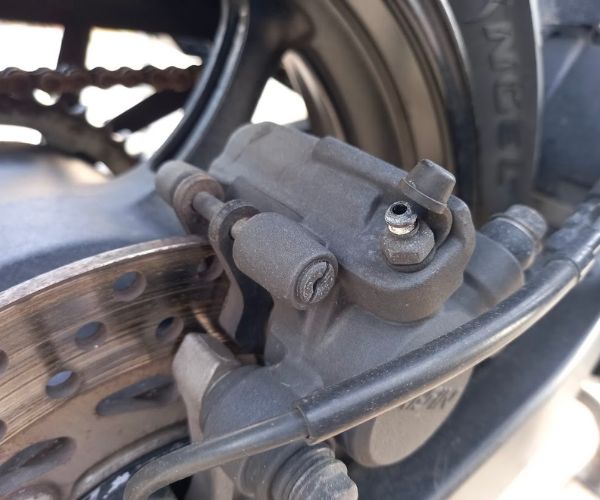
Brake fluid reservoir screws
Brake reservoir covers are often held on with two crosshead screws. The screws can quickly become corroded and seize. Soaking the screws in a release agent may help, but you may have to drill the screw out and replace it.
Master cylinder piston seal fail
This happened to me but on the clutch master cylinder. It’s quite a common fault on the Suzuki SV1000 clutch, but it surprised me. I parked the bike in the evening, and the following morning there was zero pressure on the clutch lever. The seal had failed overnight.
Luckily, the seal is simple to replace, assuming you can get one.
Air stuck in the hydraulic hoses
Sometimes, you are bleeding the brakes forever but still can’t get all the air out. A simple trick that might cure this is to close the bleed screw, then zip-tie the lever so there is constant pressure on the brake system.
Leave this overnight, and then try to bleed the brakes another time. The theory is that the constant pressure will have forced all the air bubbles down to the caliper, where you can easily bleed them out.
If this doesn’t work, you can try to vacuum-bleed the brakes. This involves using a tool to create a vacuum at the caliper end that pulls the brake fluid down from the reservoir.
Brake bleeder vacuum kits are available to do this, and they are very useful if you are having difficulty removing all the air from the system. Many professional mechanics use these kits as they are quick and can be operated by one person.
Leaking caliper seals
The pistons in the brake caliper have rubber seals to prevent fluid leaks and allow the piston to move away from the rotor once brake pressure is released.
The rubber seals can become brittle and start leaking. Repair kits are available, but if you don’t feel confident doing that type of work, you can also send the entire caliper away in exchange for a reconditioned caliper.
Old brake hoses
Over time, brake hoses begin to expand due to pressure. This will cause a loss in feel and effectiveness. A standard upgrade is to fit braided hoses that have steel braid linings to send more braking pressure from the lever to the caliper and prevent the hose from bulging.
Also see our guide to motorcycle brake bleeding problems.
